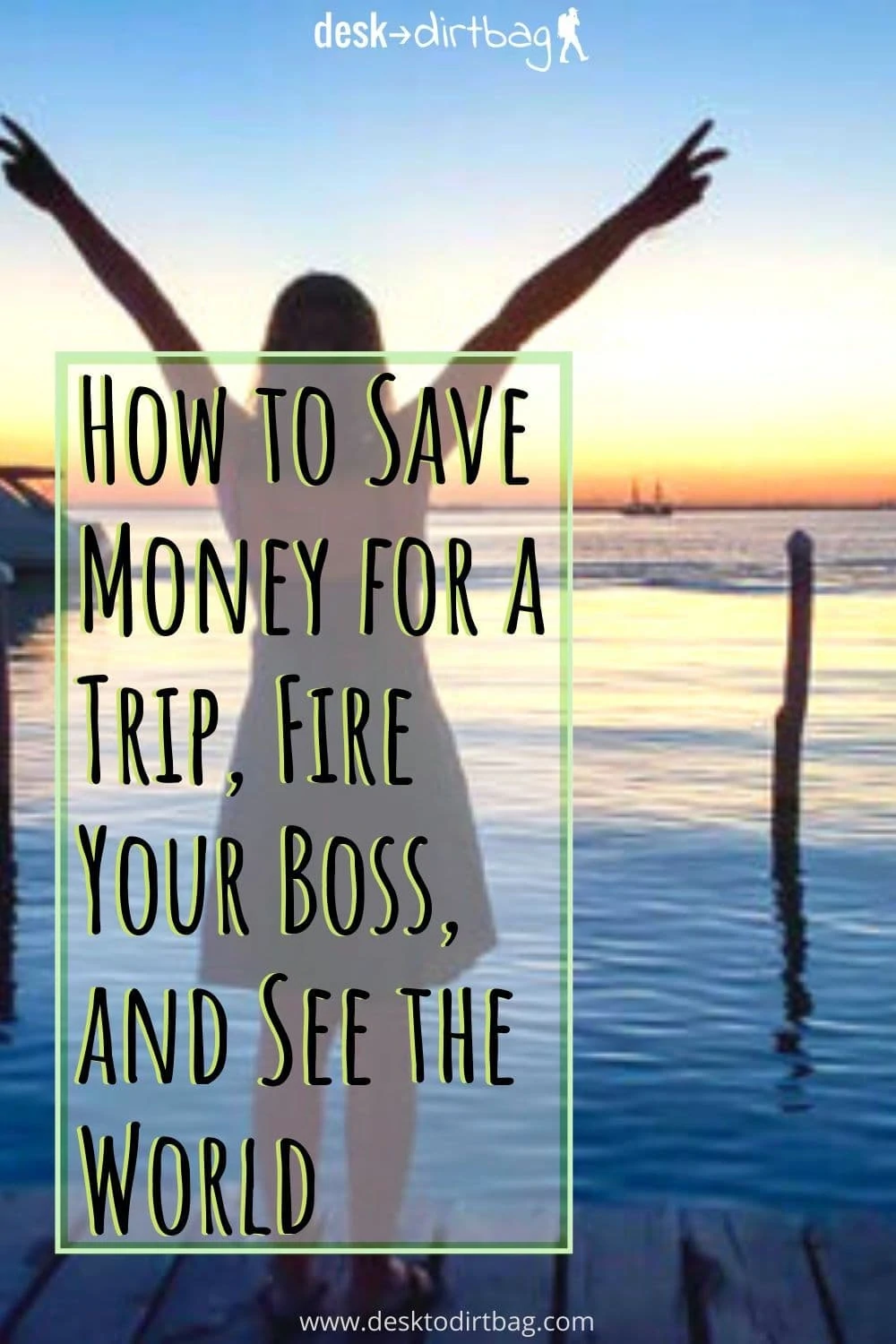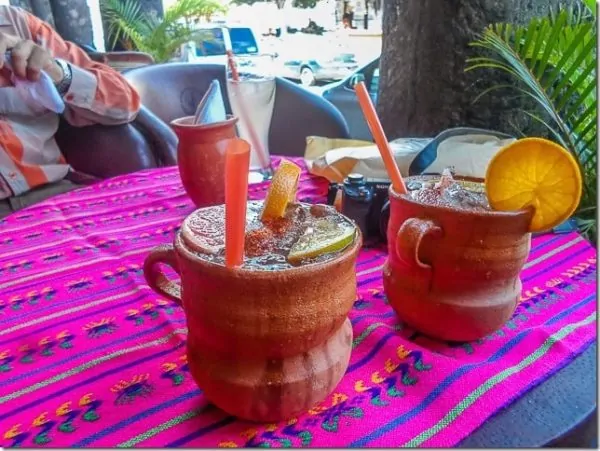The first biggest obstacle when it comes to traveling, especially long-term, is the nagging question of how to save money to travel. Everyone has this idea that travel is expensive, that it is something reserved the rich and wealthy, that you need a lucky break and lottery winnings to do so…
Basically, it all comes down to the fact that it might be possible for a lucky few, but it’s certainly “not possible for a normal person like me.”
Well, let me tell you, back before I became a rich and famous travel blogger, I was also a normal person like you.
(Haha, that’s totally a joke… I mean about the rich and famous part, not the normal person part.)
This meant that I had to put cash away each and every month to build up my travel fund, I had to scrimp and save and make sacrifices that I didn’t always want to.
I had to sacrifice the short-term now for the long-term travel.
That is the part of this whole long-term travel lifestyle that isn’t glamorous, but it’s what gets the job done.
In this post, we are going to be covering the gamut from how much it actually costs to travel the world, how to budget for travel, and how you can save money to travel. This is the type of trip where you will create life-long memories and make your friends jealous! 🙂
We’ll also talk a bit about some more advanced tactics and strategies that might not be for everybody but will take your game to the next level.
How Much Does it Cost to Travel?
Every type of adventure will have its own baseline costs and will differ depending on where you plan on going and how you plan to go about doing it.
It can be extremely tough to know how much you need to save in advance for a major undertaking such as a multi-month trip.
When I first traveling, I spent nearly a year road on an incredible West Coast road trip, living out of my truck, as I camped and explored some of the most beautiful places in the country for about $1,200 per month–a major portion spent on gas.
A year later I was living in Medellin, Colombia, with a much higher standard of living and it was about the same cost per month, but then I was able to effectively cut my costs in half by renting extra rooms on Airbnb, more or less living rent-free.
After that, I spent a good chunk of time road tripping across Central America and on over to South America. During that time I was traveling with my girlfriend and we found our per-person expenses were dramatically lower still.
I tracked three month’s of expenses and found that my share of the price per month was about what I was paying for a studio apartment back when I was in college!
So yeah, in most cases, it’s actually cheaper to travel the world than to stay home.
But I didn’t know any of these things back when I was asking myself how to save to travel, how much I would need, and whether I would go broke in three months. Yeah, I thought travel was just for rich people.
So, based on my subsequent years of continuous travel, how much would I recommend you save before you set out to travel?
How Much Savings Do You Need to Travel?
As I mentioned above, while traveling full-time in the US, backpacking in South America, and other big adventures, I was budgeting about $1,200 per month. Coincidentally, the Federal minimum wage amounts to $1,160 per month (at forty hours per week), which lines up quite well with my rolling average for travel expenses during that time.
So you’re striving to live on a minimum wage budget while traveling the world… It sounds difficult, but it is doable! It basically means, traveling on about $40 per day.
I think this $1,200 per month figure is a good benchmark to aim for in your pursuit of a long-term adventure or mini-retirement–you can adjust the figure up or down depending on the nature of your trip. We could round it up to $1,500 for a nice buffer as you learn the ins and outs of budget travel, which equates to $50 per day.
This means:
For a six month trip, you would want to have between $7,200 and $9,000 in savings.
A year-long trip you’d want from $14,400 to $18,000.
Those are some big, scary numbers, and it is a sizable amount of money, but it is doable by breaking it down a little more and by making both small and big adjustments to your current lifestyle (which is what we are building up to, you know, the whole idea of how to save to travel).
Let’s take a closer look at the math of a six-month trip, as that is a good chunk of time that most people would love to take and it is an achievable amount of money for most people.
In order to save $7,200 in a single year, you would need to put aside about $20 per day, or $600 per month.
Perhaps your departure timeline is a bit further out, and you want to save that $7,200 amount over the course of 17 months. Easy, divide that total by 17 to get $424 per month or $14 per day.
Adjust as necessary depending on your time until departure and your desired length of travel.
For this exercise, we will try to save $600 per month for 12 months to arrive at $7,200 in one year.
How to Save Money to Travel
Now that we have a goal number in mind, let’s take a step-by-step look at how we can make this ambitious savings plan a reality. Yes, it is possible to save money on a tight budget too.
If you are currently in debt, then you are not in a position to save any money for travel. You can use these same tactics to cut expenses and then put every single dollar toward paying down your debt. Once you’ve become debt free, you can start saving to travel.
Read More: Conquering Debt
Track Current Expenses
This is the first and most important step. Not knowing where your money goes (truthfully), is the easiest way to claim you “don’t have enough money to save for travel”.
You must diligently track your expenses for everything.
This sounds cumbersome, but the easiest way to do it is to put all your expenses on plastic and then use a free service like Mint.com which aggregates all your expenses across every account to give you a clear financial picture of where your money is going.
This gives you a complete picture, rather than a piecemeal approach as you see in your bank or credit card portal.
I honestly give Mint a lot of credit for helping me manage my finances and ultimately getting me traveling. I’ve been using it ever since the Desk Jockey Days.
After a month or two you will find yourself asking incredulously whether you “really spend that much at the work cafeteria?”
Yes, yes you do, so start packing lunch.
The fact is we often don’t really know or underestimate how much these expenses really amount to. That’s fine if it’s something important, but if sacrificing a few relatively meaningless things adds up to our goal of travel, then it’s worth cutting back.
TL;DR –> If you don’t track your spending, you can’t identify where you can save.
Action Step:
- Open a Mint.com account to track your spending
- Set a savings goal within Mint
Open a Travel Savings Account
The next most important step is to create a separate savings account where you will put this $600 per month.
Some banks allow the creation of a secondary savings account, but your best bet is to open a high-yield savings account at a new bank (which also makes it harder to spend, ensuring you don’t rob from your travel fund).
I did this by opening a Capital One savings account. Set it up so money automatically withdraws every month, leaving you with less money to live on and waste frivolously (more on that soon).
You could also take this time to open a Charles Schwab bank account, which is the best debit card for travelers, which will save you hundreds of dollars in ATM withdrawal fees when you are traveling. Read more about travel banking fundamentals.
Action Step:
- Open a high-yield savings account with Capital One
Cut Your Monthly Expenses
Now that we are tracking your expenses and you are going in at least once per week to accurately categorize your transactions in Mint, it is time to review your expenses and see where your money is really going.
“What gets measured, gets managed.”
If we reverse that logic, you can’t really manage your money if you aren’t measuring and tracking.
Are you spending $300 per month on bars?
$80 on your cellphone?
$100 for cable TV you barely have time to watch?
Are you spending $400 per month in groceries and end up throwing food out?
Maybe you’re spending $400 per month eating out as well?
None of these numbers are crazy. Bills add up from your vehicles, entertainment, social outings, credit card interest or late fees, etc.
While everyone’s situation is different, here are some ideas for you to consider in terms of cost-cutting and which you can redirect to your travel fund:
- Do away with a cell phone plan, most of us are connected to wifi 90% of the time. Or get a cheap prepaid cell plan like Mint Mobile (not affiliated with the other Mint we talked about) for about $15 per month.
- Get rid of cable and use only Netflix/Hulu/Amazon. Or get rid of both and use your time reading more books (like these financial literacy books) or working on a side hustle to earn more money (more on that, in a second).
- Stop driving, utilize public transport and/or start commuting by bicycle.
- Do not eat out at all. Learn to cook more and stop eating meat a day or two per week (meat is expensive and doing so could also help the planet).
- Don’t drink your calories. It makes you fat and it costs money. No beer, wine, fancy espresso drinks, or soda.
- Negotiate prices on any recurring bills you may have, explain that you need to cut expenses drastically and ask how they can help. This includes things like your internet, cell phone, cable bill, car insurance, etc.
- No new cell phones and tech. I love all that stuff, but yeah, downgrade to a cheap Android and suck it up for a year or two.
- No rideshare. Uber and Lyft are stupidly expensive in the United States. Either take a bus, a bike, or go somewhere closer.
- Don’t go to coffee shops. I love coffee, but get an Aeropress and start making it yourself.
- Use cashback portals like Rakuten for any and all purchases you make, likewise, if you’re responsible get one of these great travel credit cards to start racking up points to reduce travel costs in the future.
Remember, the goal here is to cut at least $600 worth of monthly expenses. If your disposable income is on the healthier side, you’ve got lots of wiggle room and places to cut without making major impacts to your lifestyle. If your income is close to minimum wage, then you will have to make more drastic changes, particularly to your living situation.
I’ve spoken with numerous readers who have deliberately decided to live in their trucks while working to drastically cut expenses. If you want to get ahead, you’ll have to make some big sacrifices.
The most important aspect, rather than how much you make, is how much as a percentage of income you can save. Are you able to sock away 50% of your income or 10%? You’ve got to be saving something, too many people live right at their financial limit while having all sorts of unnecessary expenses.
I know rent is crazy expensive but nobody made you move to a hot hipster city with crazy expensive rent and a horrible cost of living. If you’ve got to stay there, then you should strongly consider moving to a less than ideal living situation, whether that means shared housing, living further away, or doing another type of house hack as we discussed.
Rent shouldn’t be more than about 30% of your income. That means if you’re paying $1,500 per month, you should be earning $5,357 per month. If you’re only earning $45,000 per year, then you shouldn’t be spending more than $1,125 per month on rent. If you’re blowing more than 50% of your income on rent/mortgage, you are in an emergency type situation that needs to be addressed ASAP.
Earn More Money
We’ve covered some big and small ways to save money to travel, but the fact is that you can only reduce your living expenses and cut back so much before you reach a “floor” that you can’t pass.
While living frugally is super important when it comes to saving for travel — and an important practice phase for when you start traveling on a budget — the best synergistic effect is to earn more money in addition to reducing expenses.
This could mean asking for a raise at work, taking on a second job, or just learning how to earn extra money on the side.
Let’s say you start a side hustle or begin freelancing while you are still working the desk job in order to reach that $600 of savings per month figure.
Let’s say you find some success with a few extra hours each night and manage to earn $300 more per month — now you only need to cut your living expenses by $300 per month ($10 per day), a much more manageable figure
This is a significant achievement that can lessen the burden of scrimping and saving, but it would be even better to combine that scrimping and saving with increased earning, ie cutting your expenses by $600 per month AND increasing your earning by $300 per month.
Even a measly extra $300 will allow you to save up the necessary amount of $7,200 much faster, or allow you to save more money than expected and travel for longer.
- Save $900 per month means reaching the goal of $7,200 in 8 months instead of 12, OR
- Save $900 per month for the planned year amounts to $10,800 — an extra $3,600.
Perhaps most important with respect to earning money on the side is that, if done right, you can continue to earn money while you are traveling.
Remember how I mentioned that you should plan for $1,200 per month in expenses while traveling?
Well, if you save enough to travel for six months AND can continue to earn that $300 extra per month (ie working part-time while traveling) you bring your monthly out of pocket expenses to $900 — meaning your savings last much longer.
With your $7,200 savings and earning $300 per month you would be able to travel for 8 months instead of 6 months–that’s two WHOLE extra months.
Check out the Side Hustle Calculator for a better idea of how this works, with an interactive calculator allowing you to change monthly expenses, total savings, and side hustle earnings to see how they all interact together.
If you are living or adventuring for even cheaper–say, living in SE Asia for $600 per month as is so popular (check out Nomad List for cost of living estimates around the world)–this effect is even more pronounced. You could double the length of your trip at that point.
- $600 expenses per month on $7,200 savings = 12 months
- $600 expenses per month on $7,200 savings + $300 per month side hustle = 24 months
Travel Cheaper
Learning the fundamentals of travel hacking you can also book what would otherwise be insanely expensive flights for pennies on the dollar.
Steve Kamb of Nerd Fitness booked a Round The World (RTW) trip to four continents for only $418. I myself have used travel hacking to get free flights that would have cost me well over $1,000 overall, and have even used them to get super cheap first class tickets for just $100.
If you know the tricks of the trade, you can reduce your travel expenses drastically (which is how I manage to travel for around $1,200 per month or less).
You can even reduce your accommodation expenses to basically zero — just check out my guide to getting cheap accommodation (sometimes even FREE!) and read more about How to Travel the World on a Budget so you can stretch your dollars as much as possible.
In Tim Ferriss’ first book, the Four Hour Workweek, he talked a lot about how no one actually wants to be a millionaire and have one million dollars sitting around in a bank somewhere. They want to live a lifestyle that they think millionaires live, mostly related to time and freedom.
Side Note: Although if you DID have one million dollars in a high yield savings account earning 1.5%, that would equal $15,000 per year or $1,250 per month, basically allowing to travel on $40 per day indefinitely. Not bad! 🙂
One exercise he introduced in the book is called “dreamlining” whereby you create your ideal lifestyle, whatever that may be, and breakdown the actual costs.
Maybe it’s renting a nice big apartment in Latin America, hiring a clean lady to take care of things, eating out at restaurants every day and never cooking, taking private Spanish lessons, learning to play guitar, writing your book, etc.
Those are all things I’ve done, by the way.
Whatever it is that you want to do, figure out the costs because it probably isn’t as expensive as you think, especially when you leverage the power of the dollar in other currencies.
Once you have the monthly cost you work backward from there and know exactly how much you need to have on hand, and how much you would need to earn or have to maintain it indefinitely.
In other parts of the world, you may be surprised at how cheap it can be, and how far the dollar can take you. Indeed, it is way cheaper to travel the world than staying home.
Maybe your dream trip or lifestyle is somewhat expensive, maybe it isn’t. The first step is knowing what you want, and what it will cost. At least now you’ve got a good idea of how to save for a how trip or long-term travel and how to make it actually happen (not just dream about it).
Read Next: Budget Travel Tips
What do you think? What other ways can you save money every month? Sound off in the comments below.
Additional Resources to Save Money to Travel
- Do You Have a Trust Fund? – My thoughts on financing long term travel and whether you need to be rich.
- Conquering Debt Mountain – How to tackle your debt.
- Get Your Financial House in Order – Simple steps everyone must address to be financially savvy.
- Best Financial Literacy Books – Start reading these books first to master your finances.
- Mint.com – That personal finance app that is a must-have for anybody, not just travelers.
- Nomad List – Cost of living estimates around the world.
- Vagabonding – An excellent book that truly dispelled the idea that long-term travel was expensive.
- The Four Hour Work Week – The book that really started this whole idea of becoming location independent for me.
- 40+ Side Hustle Jobs – My article on earning more while you are working and/or traveling.
Share This
Did you enjoy this post about how to save money to travel? Before you fire your boss, please take a moment to share it on Facebook, Pinterest, or Twitter.
Ryan
Latest posts by Ryan (see all)
- Kazakhstan Food: Exploring Some of its Most Delicious Dishes - August 7, 2023
- A Self-Guided Tour of Kennedy Space Center: 1-Day Itinerary - August 2, 2022
- Fairfield by Marriott Medellin Sabaneta: Affordable and Upscale - July 25, 2022
- One of the Coolest Places to Stay in Clarksdale MS: Travelers Hotel - June 14, 2022
- Space 220 Restaurant: Out-of-This-World Dining at Disney’s EPCOT - May 31, 2022








